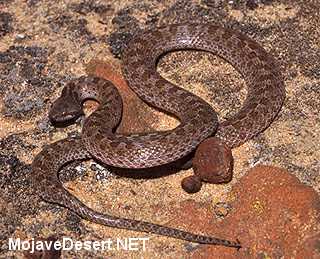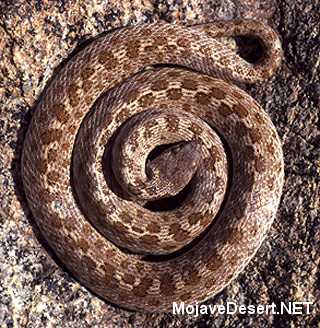Night Snake
Hypsiglena torquataFamily: Colubridae Order: Squamata Class: Reptilia
DISTRIBUTION, ABUNDANCE, AND SEASONALITY
Night snakes are uncommon to locally common in suitable habitat. They occur in the
northern Sacramento Valley and in the foothills surrounding the entire Central Valley.
Widespread in southern California including Santa Cruz Island, night snakes are absent from
the southern Sacramento and San Joaquin valleys, high elevations in the Sierra Nevada, the
outer Coast Ranges north of San Luis Obispo Co., and coastal northern California. Although
known only from an isolated locality in eastern Siskiyou Co., night snakes probably range
throughout much of arid northeastern California. Found in a variety of valley-foothill habitats,
chaparral, and
desert shrub habitats.
Elevation sea level to 1920 m (7000 ft).
SPECIFIC HABITAT REQUIREMENTS
Feeding: The saliva of this snake is mildly venomous, which may help them secure small
prey, especially
lizards
and occasional amphibians (Stebbins 1954).
Cover: When not active this snake seeks cover in crevices in rocky outcrops, under
surface objects, and in mammal burrows. The subterranean tendencies of this snake are
evidenced by its being found occasionally by roadbuilding crews.
Reproduction: The eggs of this species are laid in crevices in rocky accumulations.
Abandoned mammal burrows may also occasionally be utilized as nest sites.
Water: No information on water requirements. This is a snake of arid regions and is often
found far from standing water, which is not considered to be an important habitat element.
Pattern: Night snakes are most commonly associated with rocky areas or rock outcrops in
a variety of habitats.
SPECIES LIFE HISTORY
Activity Patterns: Nocturnal and crepuscular, night snakes are almost never encountered
abroad during the day. Periods of inactivity during cold weather occur at all localities.
Seasonal Movements/Migration: Predictable seasonal movements have not been reported
for this species.
Home Range: The nature of the home range of night snakes is unknown.
Territory: No evidence for the territorial defense of resources has been reported.
Reproduction: Eggs are laid in June and July. Females deposit 3 to 9 (usually 4) eggs,
which hatch in about two months.
Niche: Night snakes are probably taken as prey by
owls,
nocturnal mammals, and other
snakes.
The nature of their competitive relationships with other species is not well
understood.
Also see:
Death Valley Snakes
California Lyre Snake Trimorphodon biscatatus vandenburghi Nocturnal; rocky areas; sea level to over 4000 ft. Desert Night Snake Hysiglena torquata ...
Joshua Tree National Park Wildlife
Desert Night Snake Hypsiglena torquata deserticola Most common in rocky areas (common) California Kingsnake Lampropeltis getula californiae ...
Tree of Life, the Joshua Tree - Natural Science: Joshua Tree
The spotted night snake crawls among the dead tree limbs searching for its favorite prey- yucca night lizards. < Previous - Next > ...
Side-blotched Lizard - Desert Wildlife
Snake predators include rattlesnakes and sidewinders, coachwhips racers, gopher snakes, kingsnakes, patch-nosed snakes, long-nosed snakes and night snakes. ...
REFERENCES
Clark, D. R., Jr., and C. S. Lieb. 1973. Notes on reproduction in the night snake (Hypsiglena torquata). Southwest. Nat. 18:248-252.
Stebbins, R. C. 1954. Amphibians and reptiles of western North America. McGraw-Hill, New York. 536pp.
California Department of Fish and Game. California Interagency Wildlife Task Group.
EXTERNAL LINKS
Reptiles
Xantusia vigilis Desert Night Lizard; Lagartija Nocturna del Desierto ... Hypsiglena torquata Night Snake; Culebra Nocturna ...
DGM's Homepage
Rodríguez-Robles, J. A., D. G. Mulcahy and H. W. Greene. 1999. The feeding ecology of the desert night snake Hypsiglena torquata (Colubridae). ...
Southern California Herps
Xantusia vigilis - Desert Night Lizard (Yucca Night Lizard) ... Thamnophis elegans - Western Terrestrial Garter Snake (click on images below) ...
Hypsiglena torquata deserticola - Desert Nightsnake
Often seen crossing desert roads on warm nights. ... The San Diego Night Snake, H. t. klauberi, and the Spotted Night Snake, H. t. ochrorhyncha, ...
Night Snake (Hypsiglena torquata)
The night snake is easily distinguished from the latter by a tail that tapers to a point and the absence of a rattle. The night snake has a pair of large, ...
Hypsiglena torquata (Night Snake)
Night Snakes are nocturnal, making them difficult to find. They can be encountered by turning objects or during the night on desert roads. ...
Hypsiglena torquata
Hypsiglena torquata jani. Texas Night Snake ... 1860); Desert Night Snake, Hypsiglena torquata deserticola (Tanner, 1966) ...
About Saguaro National Park: Snakes
Desert Night Snake, Hypsiglena torquata deserticola. Mesa Verde Night Snake ...
Habitat Atlas For Wildlife at Risk Species Profiles - Night Snake
Other Name: Desert Night Snake; Length: 30 - 66 cm; small and slender-bodied; Beige, yellowish or grey body, patterned with dark grey-brown blotches; ...
This school program has lesson plans and activities for grades
...The Desert Night Snake is British Columbia's only opisthoglyphous (rear-fanged) venomous snake. It is one of the smallest snakes in British Columbia with a ...

Glossy Snake
Photo by Chris Brown

Glossy Snake
Photo by Chris Brown
Additional information:
Scientific name: Hypsiglena torquata
Common name: Night Snake
Size: 9.8-13.8 in (25-35 cm)
Distinguishing characters: A pale grey, beige or light brown species; brown paired blotches on dorsum; usually three large black blotches on the neck, sometimes merging; venter whitish or yellow; flat head; vertical pupils; brown bar behind eyes; white labial scales; scales smooth, often with irridescence.
Juveniles: Similar to adults.
Dimorphism: None
Similar species: Arizona elegans: Have round pupils. Pituophis melanoleucas: Has round pupils; keeled scales. Crotalus viridis: Has rattle on tail.
Additional notes: May flatten head, coil tightly, and vibrate tail when disturbed appearing as a viper. A gentle species that is easily handled. Often found under rocks.